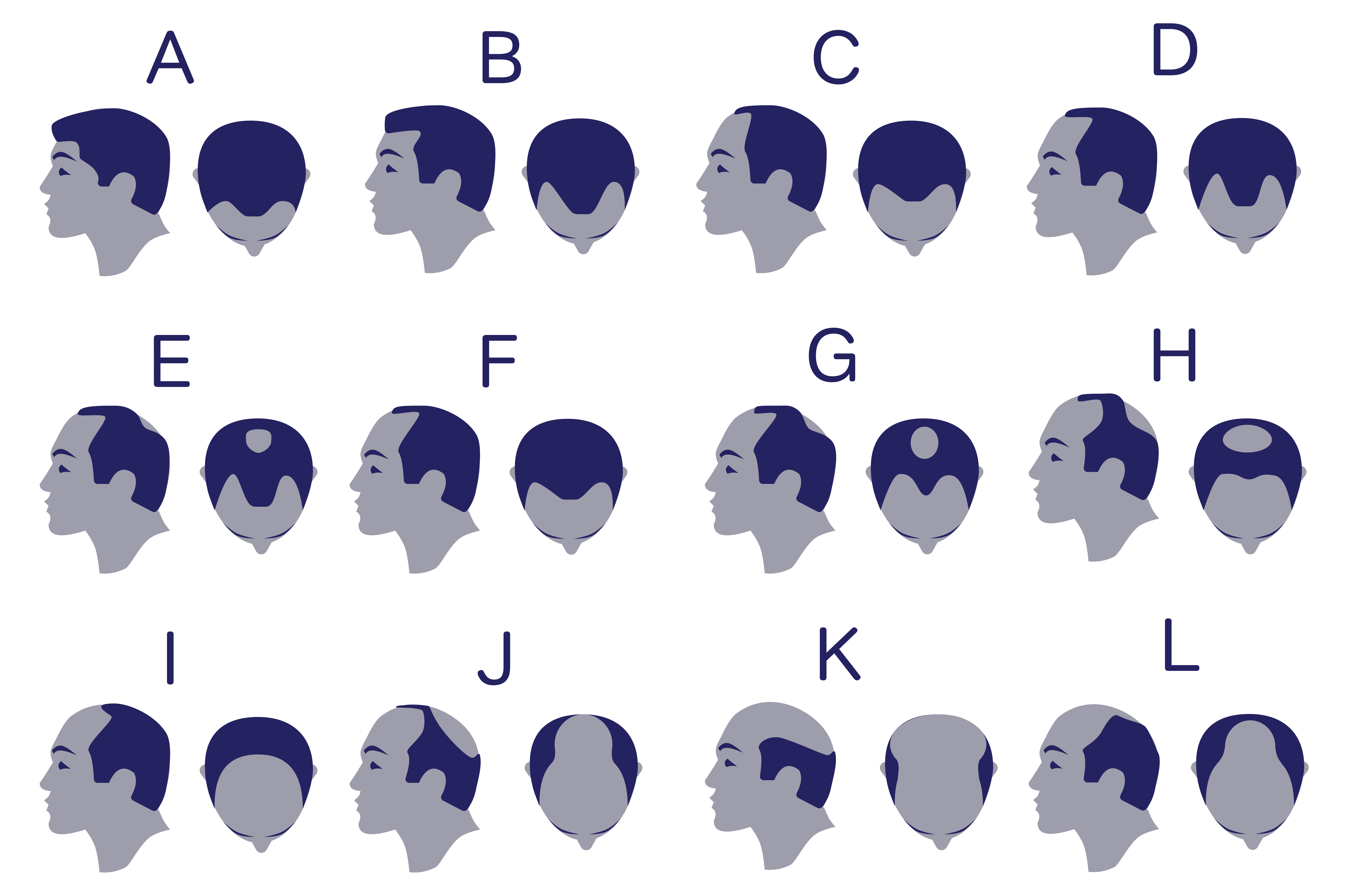Information

Written by Dr Kimberly Langdon, MD
Information last reviewed 06/21/19
About
Hair loss or baldness is extremely common and affects roughly 50% of men over the age of 40. White males have the highest incidence of hair loss with Asians and African Americans second, followed by Eskimos and Native Americans. Balding generally begins at the forehead and progresses towards the back of the head. The earlier in life that it begins, the more severe the degree of baldness.
Causes
Genetics
Male-pattern baldness is genetic, but it is passed from a mother to her son. Therefore, men often do not show the same hair loss pattern as their father. High levels of androgens (male hormones such as testosterone) can lead to hair loss.
Other causes
It is thought that other factors may be involved in hair loss besides high levels of androgens. Hair loss can also be caused by:
- Old age
- Toxic chemicals i.e. chemotherapy
- Low or high levels of thyroid hormones
- Iron deficiency
- Skin diseases affecting the scalp
- High blood pressure
- Smoking
Symptoms
What are the early signs of balding?
Signs of hair loss, otherwise known as alopecia, aren’t always easy to spot. Often, the condition can creep up on you as you unsuspectingly go about your daily life, one subtle hair at a time, until one day you look in the mirror and see a conspicuous receding hairline staring back at you. And if you thought that being in the first flush of youth makes you immune to the effects of alopecia, think again; in some cases, it can set in in your late teens or early 20s.
If you relate to the above scenario all too well, you’ll be glad to know that there are steps you can take to prevent further hair loss and even promote regrowth. However, it is also important to note that your thinning crown can be attributed to hereditary factors, hormonal changes, medical conditions, or simply as a natural part of aging, and depending on the cause, the process isn’t always reversible.
But before you can take action against balding, you need to know the early signs to look out for:
- Excessive amounts of hair in the shower drain, on your pillow case, or after brushing.
- Thinning, wispy hair around the crown, temples, and forehead, which gradually fall out and cause the hairline to recede.
- Hair takes longer than usual to grow after it has been cut.
- A family history of balding on either the maternal or paternal side.
If baldness is a concern for you, there’s no need to stress (it’ll only make you lose more hair!). Speak with a doctor or dermatologist, who will be able to diagnose the condition and prescribe a suitable treatment for you.
Balding Symptoms
The pattern of balding can vary from person to person, but the signs of male pattern baldness include:
- Gradual onset
- Hairline recedes from the forehead towards the back of the head
- Thinning of hair around the side of the forehead
- Increased hair shedding
- Change from thick pigmented hairs to thinner and shorter hairs, then to short, wispy, colorless hairs
- Thinning of hair at the top of the head
You may experience male pattern baldness in any of the following patterns. If you are experiencing hair loss in other patterns, patches or clumps, it may be caused by another condition and it is a good idea to speak to your doctor about this. 
Diagnosis
Male pattern baldness is generally diagnosed by asking the patient about the development and progression of their hair loss and by looking at the pattern of hair loss itself. Some lab tests can also be done to identify or rule out any underlying causes of hair loss. The tests can involve measuring the following:
- Blood levels of androgens such as testosterone or dihydrotestosterone (DHT)
- Iron levels and the total iron-binding capacity, which measures the blood’s capacity to bind iron with transferrin (a protein involved with transporting iron in the blood).
- Levels of thyrotropin (aka thyroid-stimulating hormone) to assess for thyroid dysfunction
Trichograms may also be carried out to assess the rate of progression of your hair loss. This involves 50-100 hairs being plucked from the scalp and examined under a microscope to measure different types of hair roots and their shapes on the scalp.
Treatment
There are two FDA approved medications for male-pattern baldness: Minoxidil and Finasteride.
Finasteride
Finasteride or Propecia is taken orally and can only be used by men. It helps to slow the progression of hair loss and can also cause new growth. Results are usually better towards the back of the head, rather than in the forehead area. It works by reducing the levels of the androgen, dihydrotestosterone (DHT), which is implicated in male pattern baldness. To prevent further hair loss, Finasteride must be continued indefinitely, because stopping it will cause the DHT to rise and hair loss to resume.
Minoxidil
Minoxidil or Rogaine is a topical lotion that stimulates and prolongs hair growth. It is thought to do this by increasing the blood flow to the hair follicles and increasing the size of the follicle and the thickness of individual hairs. Regrowth is better in the back of the head than the forehead and may take up to 4 months to show an effect. To prevent hair loss returning, it is essential to continue the topical treatment indefinitely because stopping it will cause the baldness to return rapidly.
Non-Medicinal Hair Loss Treatments
- Laser hair loss treatment or a red light hairbrush has had modest success as over-the-counter treatments to regrow hair.
- Botox injections have been shown to increase blood flow to the scalp, encouraging hair growth.
- Stem cells, growth factors, herbs, and surgical techniques such as transplantation of hair follicles and micrografting are also available to counter hair loss.
Q&A
No, but if it is done, it may demonstrate inflammation, which is thought to contribute to male-pattern baldness.
There are two, one located on the X- chromosome and thus must come from the maternal side, the other is on chromosome 20, which could come from paternal or maternal genes.
Propecia™ is the only FDA-approved prescription-grade treatment indicated for the treatment of androgenetic alopecia, also known as male pattern hair loss in men. However, it is a branded product and more expensive than the generic Finasteride, which contains the same active ingredients and is a lot cheaper. You can order Finasteride or Propecia using our online doctor’s service and have it delivered to your door.
Yes, hair loss has many types with varying causes and symptoms and stress can be one of them.
Disclaimer: This is not medical advice. You and your physician will determine if and how you should take any medication prescribed to you following a medical consultation.
- Kaya Erdogan H, Bulur I, Kocaturk E, Yildiz B, Saracoglu ZN, Alatas O. The role of oxidative stress in early-onset androgenetic alopecia. J Cosmet Dermatol. 2016 Dec 16. [Medline].
- Kim MW, Shin IS, Yoon HS, Cho S, Park HS. Lipid profile in patients with androgenetic alopecia: a meta-analysis. J Eur Acad Dermatol Venereol. 2016 Oct 7.
- Oh BR, Kim SJ, Moon JD, et al. Association of benign prostatic hyperplasia with male pattern baldness. Urology. 1998 May. 51(5):744-8.
- Polat EC, Ozcan L, Otunctemur A, Ozbek E. Relation of urinary stone disease with androgenetic alopecia and serum testosterone levels. Urolithiasis. 2016 May 7
- Richards KN, Rashid RM. Problems in pattern alopecia. J. Cosmet. Dermatol. 11(2), 131–133(2012).
- Tabolli S, Sampogna F, di Pietro C, Mannooranparampil TJ, Ribuffo M, Abeni D. Health status, coping strategies, and alexithymia in subjects with androgenetic alopecia: a questionnaire study. Am. J. Clin. Dermatol. 14(2), 139–145(2013).
- Yip L, Rufaut N, Sinclair R. Role of genetics and sex steroid hormones in male androgenetic alopecia and female pattern hair loss: an update of what we now know. Australas. J. Dermatol. 52(2), 81–88(2011).
- Sinclair RD, Dawber RP. Androgenetic alopecia in men and women. Clin. Dermatol. 19(2), 167–178(2001).
- Yip L, Zaloumis S, Irwin D et al. Gene-wide association study between the aromatase gene (CYP19A1) and female pattern hair loss. Br. J. Dermatol. 161(2), 289–294(2009).
- Randall VA. Androgens: the main regulator of human hair growth. In: Hair and Its Disorders: Biology, Pathology, and Management. Camacho FM, Randall VA, Price VH (Eds). Martin Dunitz Ltd, London, UK, 69–82(2000).
- Sawaya ME. Differences in the mechanisms of androgen action in hair follicles from women and men with androgenetic alopecia. In: Hair and Its Disorders: Biology, Pathology, and Management. Camacho FM, Randall VA, Price VH (Eds). Martin Dunitz Ltd, London, UK, 153–58(2000).
- Ahouansou S, Le Toumelin P, Crickx B, Descamps V. Association of androgenetic alopecia and hypertension. In: Eur J Dermatol. (2007)
- Lin-Hui S, Hsiu-Hsi CT. Association of Androgenetic Alopecia With Smoking and Its Prevalence Among Asian Men: A Community Based Survey. Arch Dermatol. (2007)













Quick and discreet
I ordered Azithromycin tablets for chlamydia treatment, received it next day in a brown discreet pack, and cheaper than all other pharmacies, can't ask for more
Jordan McCann